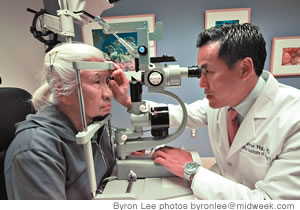
New Hope For Aging Eyes
April 14, 2010
By Dr. Gene Ng


Dr. Gene Ng
Director of Vitreoretinal Surgery at Retina Institute of Hawaii
Where did you receive your schooling and training?
I’ve completed my residency and vitreoretinal surgery fellowship at the Wilmer Eye Institute at Johns Hopkins. I completed my research fellowship in retinal diseases at Massachusetts Eye and Ear Infirmary at Harvard Medical School. I also have an MBA from Harvard Business School and spent some time in the world of drug development at Eyetech, where we developed Macugen, the first anti-VEGF treatment for wet macular degeneration, which received FDA approval in 2004.
What is age-related macular degeneration (AMD) and why is it such a serious problem?
AMD is a retinal degeneration and is a disease of aging as its name implies. It’s important because it’s the leading cause of blindness in the Western world. So both dry and wet AMD are very common conditions and are a huge public health burden, even here in Hawaii.
{embed=“elements/box_ad”}
In addition to age are there other causes?
We don’t really know what the cause is, but we know what the risk factors are. Age is the big one. Other risk factors are: race, smoking, genetics and nutrition. We know that high doses of antioxidants slow the progression of the disease.

|
What are the differences between wet and dry macular degeneration?
Ninety percent of patients have the dry form and 10 percent the wet form. The dry form is characterized by lesions in the macula called drusen. Drusen are like age spots. With the dry form the retina is degenerating very slowly and patients notice mild vision loss. The wet form is the more aggressive form, and vision loss occurs much more rapidly. It’s called wet because it’s characterized by abnormal blood vessels that grow under the retina, which leak fluid and blood. Right now a lot of the drug and device treatments that have been developed target the wet form. The dry form doesn’t have too many treatments available, but it is a very hot area of research right now.
Do each present similar symptoms?
They do, but the difference is the speed. So the dry form causes subtle changes in the central vision, some blurring and difficulty reading and such. With the wet form, you lose central vision very quickly.
Are there preventative methods or are the treatments basically to slow progression?
Eye vitamins which contain high doses of antioxidants slow the progression of the disease but they only have a modest effect. A diet rich in green leafy vegetables and fish is helpful. You can treat other risk factors such as smoking, but these are really the only things that can be done to prevent it. It’s only with the wet form that we have drugs that can actively treat the disease. While these drugs have been a major breakthrough and somewhat of a miracle for this disease, we still have limited options. Therefore ,there’s still a lot of room for improvement and there is still a need for new treatments.
{embed=“elements/google_ad336x280”}
Can you talk about AMD treatments currently being developed?
At Retina Institute of Hawaii we are very much at the cutting edge of the newest and latest developments. We have been involved in a lot of trials in the last four to five years, but there are two that we’re particularly excited about and involved in. One is a medical device approach to wet AMD and it’s by a company called Neovista. They have a device called the EpiRad, which is a radiotherapy device. The reason why this device is very interesting is that currently for wet AMD, you need to have monthly injections and that’s a burden for the patient. This device is a microsurgical procedure that allows us to place a probe which delivers radiation right over the lesion in the retina. Because it’s such a targeted delivery there are very limited side effects, and so far in the late stage clinical trials we have seen very promising results.
The other treatment we are excited about is from Alcon. We are waiting to start a dry AMD trial with a drug they have called POT-4. This is a drug that can be potentially used for dry AMD and targets the inflammation pathway called complement. They’ll be starting Phase 2 clinical trials.